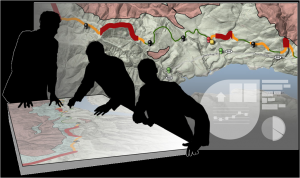About

Changing the Future of First Response Cooperation
The events to which the emergency management community must respond occur across a range of time scales and planning horizons. Some incidents are short duration, unforeseen events that require immediate coordination. Others such as hurricanes provide some advance warning but demand long-term response and recovery activities in their aftermath. Enduring events such as droughts and environmental change offer long-term planning and mitigation challenges. In all cases, however, there is a need to provide planners and responders with precise, relevant information and with tools that aid collaboration, information sharing, and decision support. Those on the front line often experience information overload as multiple agencies provide critical information and tools for support. Whether events are planned or unexpected, a tighter collection of cooperative methods and data sources can address these challenges and the face of event response.
Researchers at Pacific Northwest National Laboratory are developing future work environments for the emergency management community called Precision Information Environments (or PIEs). PIEs will provide tailored access to information and decision support capabilities in a system that supports the multiple user roles, contexts, and phases of emergency management, planning, and response. A PIE will provide its capabilities through novel interactive interfaces that transform the way stakeholders – from first responders to policy makers to the public – engage with each other and with information. These new approaches will result in multi-data type, multi-use environments based on a common hardware and software architecture.
PIEs will integrate modeling and simulation, visual analysis, real-time and historical data streams, and context- aware interfaces in an approachable, easy-to-use decision support and collaboration system. Information and visual interfaces will be tailored to the specific roles and tasks of each user, and information sharing between users will be seamless and targeted. The goal is real-time synthesis, communication, and analysis of dynamically generated and collected information, providing the basis for sound decision making. PIEs will allow users to engage with each other in new ways, leveraging their collective expertise and experience in both synthetic and augmented reality environments that combine physical models, live multimodal data streams, and visualization tools that support actions, assessments, and decision making.
Precision Information Environments can enable:
- Response personnel to gather useful information and enhance situation awareness.
- Emergency and incident management personnel to make more informed decisions sooner through the novel presentation of tailored, real-time, reality-based, and relevant information.
- Decision makers to have a tool to explore in, real-time, the available information, what- if scenarios, impact, consequences and outcomes while doing exercises and planning activities.
- Policymakers to have an up-to-date, on-the-scene level of information without being overloading with detail.
- More realistic and relevant simulation and training tailored for the specific needs of individual locations and situations.
- Better threat anticipation by revealing key vulnerabilities during planning and simulation.
- More accurate and timely planning, and more effective recovery and restoration action.
Once developed, PIEs will provide integrated support for emergency planning and response, training, threat analysis, and policy making.


